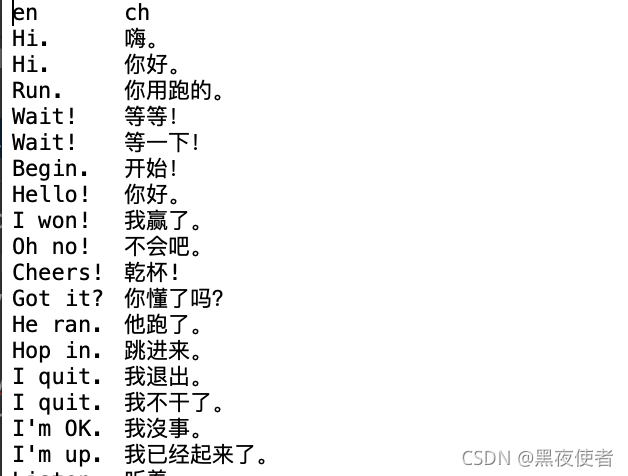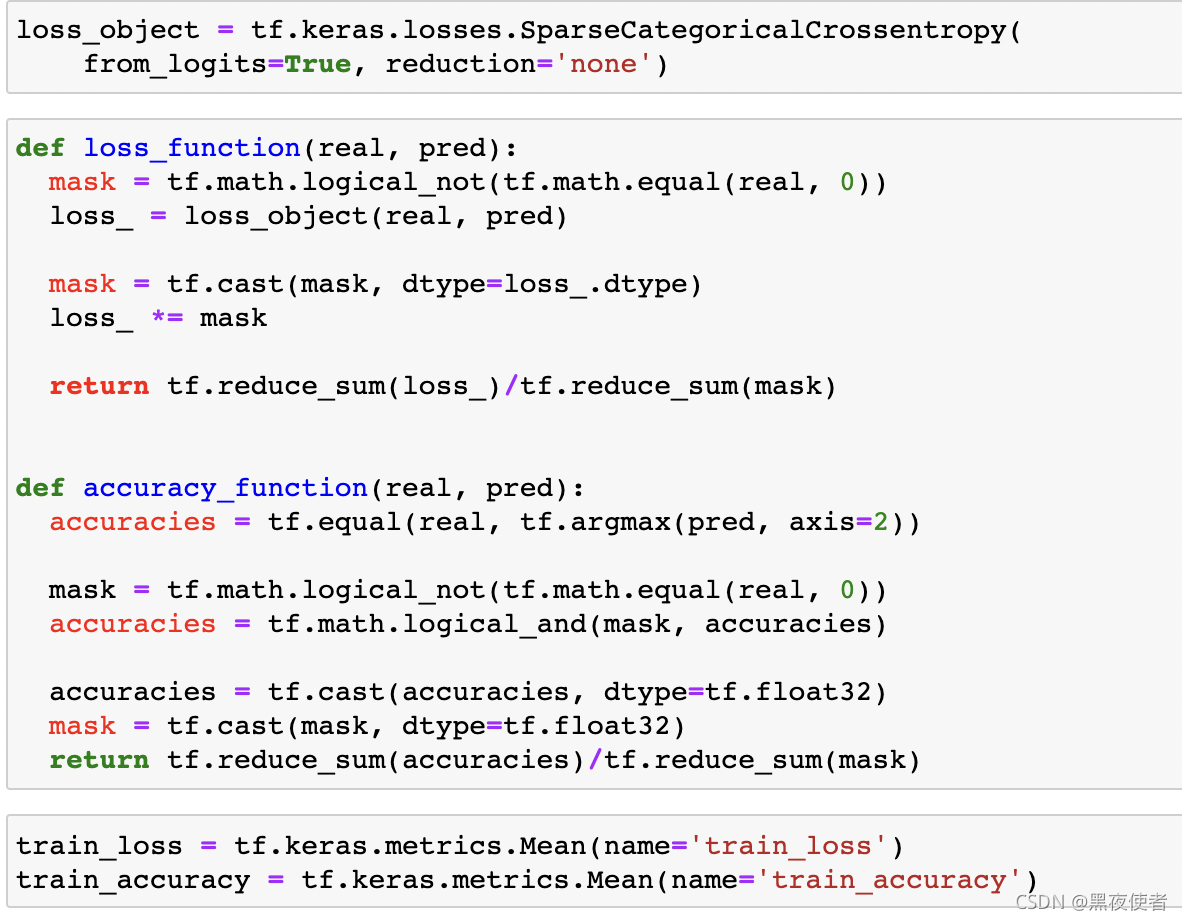用tensorflow实现Transformer中英文翻译
个人感想
最近写简历的时候发现简历无法体现出我的实力,比如在简历中写代码能力很强这句话,hr压根看不出你什么水平,可能每个人简历都会写这么一句话。像我这样能力超群,在简历中显得苍白无力。打比赛从来都是自己组队,也没拿过名次。以前总是嫌写博客太浪费时间就没写,现在想想有点后悔。写博客在简历中加个链接至少能让他们了解一下你的水平。所以奉劝大家没事也写写吧。
transformer
简介
transformer 的理论请去仔细阅读Attention Is All You Need 这篇论文。不过如果要想真正理解transformer,还是需要写一遍代码实现。只看理论讲解会忽略很多细节,而且忘的也快。这次写一遍代码让我发现了很多细节,也更加深刻的理解transformer了。本次教程代码参考了官方代码。接下来我将逐步讲解每步代码,有不懂的地方可以评论问我。
数据集准备
下载地址:http://www.manythings.org/anki/ 解压后有个cmn.txt ,来看下里面的内容:

可以看到后面有无用数据,需要处理。
数据处理
这里我用正则去掉每行cc-by及后面内容,然后用pandas生成一个新的文件。代码如下:
path = './data/cmn.txt'
lines = io.open(path, encoding='UTF-8').read().strip().split('\n')
# print(lines[:5])
newl = list(map(lambda x: re.sub(r'CC-BY.*$', "", x).strip(), lines))
d =pd.DataFrame(newl)
d.to_csv('./data/cmn.txt',index=False,header=False)
处理完如下:

开始写transformer了
导入依赖
import time
import numpy as np
import matplotlib.pyplot as plt
import pandas as pd
import tensorflow as tf
这里说一下我的tensorflow版本是2.5.0 ,现在2.6.0已经可以用了,如果你用的是2.6.0下面有个地方会出错,因为他源码移位置了。
第一步 构建词库,单词转化为数字
这一步中英文的比较简单,中文的要稍微麻烦一点。
首先使用tf.data 读取数据集

说明一下,这里的batch 设的这么大是为了构建词库,不是用来训练的。这个文件里行数是小于25000的,所以一个batch就读完比较方便处理。
接下来为分词做准备,定义两个方法
def tf_lower_and_split_punct(text):
text = tf.strings.lower(text)
# Add spaces around punctuation.
text = tf.strings.regex_replace(text, '[.?!,?]', r' \0 ')
# Strip whitespace.
text = tf.strings.strip(text)
text = tf.strings.join(['[START]', text, '[END]'], separator=' ')
return text
def tf_lower_and_split_punct2(text):
# Split accecented characters.
text = tf.strings.unicode_split(text,input_encoding='UTF-8')
text = tf.strings.reduce_join(text, axis=-1, separator=' ')
text = tf.strings.join(['[START]', text, '[END]'], separator=' ')
# # Keep space, a to z, and select punctuation.
# text = tf.strings.regex_replace(text, '[^ a-z.?!,?]', '')
# Add spaces around punctuation.
# Strip whitespace.
text = tf.strings.strip(text)
return text
第一个方法是英文处理,先是都转成小写,然后标点符号前后加空格(因为以空格分词),最后在开始加上【start】,结尾加上【end】。中文的处理麻烦一点,要把中文先用空格分隔,然后跟英文处理类似。注意这个start和end 是必须加的,不一定非的是这两个词,充当信标的作用,翻译的时候decode里面必须有词输入,start作为第一个输入。
使用TextVectorization layer来构建词库,它能构建词库,并将输入的单词转化为token。举个例子 ,有个tensor a的内容是 [i love you],vectorize_layer(a)就会变成 [4,6,7],其标准化的方法就是我们刚才定义的。
vectorize_layer = tf.keras.layers.experimental.preprocessing.TextVectorization(
max_tokens=None,standardize=tf_lower_and_split_punct,
output_sequence_length=None
)
vectorize_layer2 = tf.keras.layers.experimental.preprocessing.TextVectorization(
max_tokens=None,standardize=tf_lower_and_split_punct2,
output_sequence_length=None
)
这两个layer需要adapt,
for line in dataset.take(1):
ee = line['en']
cc = line['ch']
vectorize_layer.adapt(ee)
vectorize_layer.adapt2(cc)
不理解的请自己去学tensorflow,我就不细讲每个的用法了。
可以查看下词库

位置编码
transformer 能摆脱rnn做到并行计算离不开位置编码
参照论文里的这个公式

def get_angles(pos, i, d_model):
angle_rates = 1 / np.power(10000, (2 * (i // 2)) / np.float32(d_model))
return pos * angle_rates
def positional_encoding(position, d_model):
angle_rads = get_angles(np.arange(position)[:, np.newaxis],
np.arange(d_model)[np.newaxis, :],
d_model)
# apply sin to even indices in the array; 2i
angle_rads[:, 0::2] = np.sin(angle_rads[:, 0::2])
# apply cos to odd indices in the array; 2i+1
angle_rads[:, 1::2] = np.cos(angle_rads[:, 1::2])
pos_encoding = angle_rads[np.newaxis, ...]
return tf.cast(pos_encoding, dtype=tf.float32)
其中pos是一个常数,d_model是embeding的维度,i就是0到d_model中的一个数。
mask

这里有两个mask,很多人不理解这个mask是什么,mask的作用是什么。我来解释下,对于第一个mask,在一个batch中比如64个,这个64个句子长度不可能都一样,而我们输入需要同样的长度,所以句子少于最长的那个句子的地方就会用0填充。然而在计算loss的时候这些填充的不应该去计算loss,所以mask 就是一个是0或1的tensor,对应句子填充0的地方mask就是1. 举例[45,21,0,0,0] 的mask就是 [0,0,1,1,1]。
对于第二个mask 是在decode中预测下一个单词的时候只能用已有的单词。举例,句子是。[78,21,34,56,0,0,0] , 当预测21时,mask是[0,1,1,1,1,1],当预测34是,mask是[0,0,1,1,1,1],以此类推。
注意力

def scaled_dot_product_attention(q, k, v, mask):
matmul_qk = tf.matmul(q, k, transpose_b=True) # (..., seq_len_q, seq_len_k)
# scale matmul_qk
dk = tf.cast(tf.shape(k)[-1], tf.float32)
scaled_attention_logits = matmul_qk / tf.math.sqrt(dk)
# add the mask to the scaled tensor.
if mask is not None:
scaled_attention_logits += (mask * -1e9)
# softmax is normalized on the last axis (seq_len_k) so that the scores
# add up to 1.
attention_weights = tf.nn.softmax(scaled_attention_logits, axis=-1) # (..., seq_len_q, seq_len_k)
output = tf.matmul(attention_weights, v) # (..., seq_len_q, depth_v)
return output, attention_weights
这个学transformer的应该最熟悉了,就不多解释了。如果你是代码不懂什么意思,请点进去看源码。

下面两个是encode layer中的多头注意力和前馈神经网络
class MultiHeadAttention(tf.keras.layers.Layer):
def __init__(self, d_model, num_heads):
super(MultiHeadAttention, self).__init__()
self.num_heads = num_heads
self.d_model = d_model
assert d_model % self.num_heads == 0
self.depth = d_model // self.num_heads
self.wq = tf.keras.layers.Dense(d_model)
self.wk = tf.keras.layers.Dense(d_model)
self.wv = tf.keras.layers.Dense(d_model)
self.dense = tf.keras.layers.Dense(d_model)
def split_heads(self, x, batch_size):
"""Split the last dimension into (num_heads, depth).
Transpose the result such that the shape is (batch_size, num_heads, seq_len, depth)
"""
x = tf.reshape(x, (batch_size, -1, self.num_heads, self.depth))
return tf.transpose(x, perm=[0, 2, 1, 3])
def call(self, v, k, q, mask):
batch_size = tf.shape(q)[0]
q = self.wq(q) # (batch_size, seq_len, d_model)
k = self.wk(k) # (batch_size, seq_len, d_model)
v = self.wv(v) # (batch_size, seq_len, d_model)
q = self.split_heads(q, batch_size) # (batch_size, num_heads, seq_len_q, depth)
k = self.split_heads(k, batch_size) # (batch_size, num_heads, seq_len_k, depth)
v = self.split_heads(v, batch_size) # (batch_size, num_heads, seq_len_v, depth)
# scaled_attention.shape == (batch_size, num_heads, seq_len_q, depth)
# attention_weights.shape == (batch_size, num_heads, seq_len_q, seq_len_k)
scaled_attention, attention_weights = scaled_dot_product_attention(
q, k, v, mask)
scaled_attention = tf.transpose(scaled_attention,
perm=[0, 2, 1, 3]) # (batch_size, seq_len_q, num_heads, depth)
concat_attention = tf.reshape(scaled_attention,
(batch_size, -1, self.d_model)) # (batch_size, seq_len_q, d_model)
output = self.dense(concat_attention) # (batch_size, seq_len_q, d_model)
return output, attention_weights
def point_wise_feed_forward_network(d_model, dff):
return tf.keras.Sequential([
tf.keras.layers.Dense(dff, activation='relu'), # (batch_size, seq_len, dff)
tf.keras.layers.Dense(d_model) # (batch_size, seq_len, d_model)
])
这里我们可以清楚的看到多头注意力是怎么实现的。举个例子, 一个(64,10,20 )的input,分别代表意思是(batch,句子长度,embeding维度) ,假设需要4头,就会reshape成(64,10,4,5),然后转置成(64,4,10,5),然后计算attention,然后转置成(64,10,4,5),然后concat 回 (64,10,20)
有了这两个sub layer 就可以实现单个encode layer了
class EncoderLayer(tf.keras.layers.Layer):
def __init__(self, d_model, num_heads, dff, rate=0.1):
super(EncoderLayer, self).__init__()
self.mha = MultiHeadAttention(d_model, num_heads)
self.ffn = point_wise_feed_forward_network(d_model, dff)
self.layernorm1 = tf.keras.layers.LayerNormalization(epsilon=1e-6)
self.layernorm2 = tf.keras.layers.LayerNormalization(epsilon=1e-6)
self.dropout1 = tf.keras.layers.Dropout(rate)
self.dropout2 = tf.keras.layers.Dropout(rate)
def call(self, x, training, mask):
attn_output, _ = self.mha(x, x, x, mask) # (batch_size, input_seq_len, d_model)
attn_output = self.dropout1(attn_output, training=training)
out1 = self.layernorm1(x + attn_output) # (batch_size, input_seq_len, d_model)
ffn_output = self.ffn(out1) # (batch_size, input_seq_len, d_model)
ffn_output = self.dropout2(ffn_output, training=training)
out2 = self.layernorm2(out1 + ffn_output) # (batch_size, input_seq_len, d_model)
return out2
单个layer的作用,可以看到input 先进入多头注意力,然后用残差连接防止梯度消失,然后归一化,后进入前馈神经网络,然后用残差连接防止梯度消失,然后归一化。
再来看看单个decode layer
class DecoderLayer(tf.keras.layers.Layer):
def __init__(self, d_model, num_heads, dff, rate=0.1):
super(DecoderLayer, self).__init__()
self.mha1 = MultiHeadAttention(d_model, num_heads)
self.mha2 = MultiHeadAttention(d_model, num_heads)
self.ffn = point_wise_feed_forward_network(d_model, dff)
self.layernorm1 = tf.keras.layers.LayerNormalization(epsilon=1e-6)
self.layernorm2 = tf.keras.layers.LayerNormalization(epsilon=1e-6)
self.layernorm3 = tf.keras.layers.LayerNormalization(epsilon=1e-6)
self.dropout1 = tf.keras.layers.Dropout(rate)
self.dropout2 = tf.keras.layers.Dropout(rate)
self.dropout3 = tf.keras.layers.Dropout(rate)
def call(self, x, enc_output, training,
look_ahead_mask, padding_mask):
# enc_output.shape == (batch_size, input_seq_len, d_model)
attn1, attn_weights_block1 = self.mha1(x, x, x, look_ahead_mask) # (batch_size, target_seq_len, d_model)
attn1 = self.dropout1(attn1, training=training)
out1 = self.layernorm1(attn1 + x)
attn2, attn_weights_block2 = self.mha2(
enc_output, enc_output, out1, padding_mask) # (batch_size, target_seq_len, d_model)
attn2 = self.dropout2(attn2, training=training)
out2 = self.layernorm2(attn2 + out1) # (batch_size, target_seq_len, d_model)
ffn_output = self.ffn(out2) # (batch_size, target_seq_len, d_model)
ffn_output = self.dropout3(ffn_output, training=training)
out3 = self.layernorm3(ffn_output + out2) # (batch_size, target_seq_len, d_model)
return out3, attn_weights_block1, attn_weights_block2
decode layer中做了两次attention,首先把target input 用ahead mask 做attention。然后残差归一化后把这次attention的结果做q, encode的输出做k,v再进行attention,然后跟encode中一样了。
encode decode transform
这个没啥难的,就是组装layer
class Encoder(tf.keras.layers.Layer):
def __init__(self, num_layers, d_model, num_heads, dff, input_vocab_size,
maximum_position_encoding, rate=0.1):
super(Encoder, self).__init__()
self.d_model = d_model
self.num_layers = num_layers
self.embedding = tf.keras.layers.Embedding(input_vocab_size, d_model)
self.pos_encoding = positional_encoding(maximum_position_encoding,
self.d_model)
self.enc_layers = [EncoderLayer(d_model, num_heads, dff, rate)
for _ in range(num_layers)]
self.dropout = tf.keras.layers.Dropout(rate)
def call(self, x, training, mask):
seq_len = tf.shape(x)[1]
# adding embedding and position encoding.
x = self.embedding(x) # (batch_size, input_seq_len, d_model)
x *= tf.math.sqrt(tf.cast(self.d_model, tf.float32))
x += self.pos_encoding[:, :seq_len, :]
x = self.dropout(x, training=training)
for i in range(self.num_layers):
x = self.enc_layers[i](x, training, mask)
return x # (batch_size, input_seq_len, d_model)
class Decoder(tf.keras.layers.Layer):
def __init__(self, num_layers, d_model, num_heads, dff, target_vocab_size,
maximum_position_encoding, rate=0.1):
super(Decoder, self).__init__()
self.d_model = d_model
self.num_layers = num_layers
self.embedding = tf.keras.layers.Embedding(target_vocab_size, d_model)
self.pos_encoding = positional_encoding(maximum_position_encoding, d_model)
self.dec_layers = [DecoderLayer(d_model, num_heads, dff, rate)
for _ in range(num_layers)]
self.dropout = tf.keras.layers.Dropout(rate)
def call(self, x, enc_output, training,
look_ahead_mask, padding_mask):
seq_len = tf.shape(x)[1]
attention_weights = {}
x = self.embedding(x) # (batch_size, target_seq_len, d_model)
x *= tf.math.sqrt(tf.cast(self.d_model, tf.float32))
x += self.pos_encoding[:, :seq_len, :]
x = self.dropout(x, training=training)
for i in range(self.num_layers):
x, block1, block2 = self.dec_layers[i](x, enc_output, training,
look_ahead_mask, padding_mask)
attention_weights[f'decoder_layer{i + 1}_block1'] = block1
attention_weights[f'decoder_layer{i + 1}_block2'] = block2
# x.shape == (batch_size, target_seq_len, d_model)
return x, attention_weights
class Transformer(tf.keras.Model):
def __init__(self, num_layers, d_model, num_heads, dff, input_vocab_size,
target_vocab_size, pe_input, pe_target, rate=0.1):
super().__init__()
self.encoder = Encoder(num_layers, d_model, num_heads, dff,
input_vocab_size, pe_input, rate)
self.decoder = Decoder(num_layers, d_model, num_heads, dff,
target_vocab_size, pe_target, rate)
self.final_layer = tf.keras.layers.Dense(target_vocab_size)
def call(self, inputs, training):
# Keras models prefer if you pass all your inputs in the first argument
inp, tar = inputs
enc_padding_mask, look_ahead_mask, dec_padding_mask = self.create_masks(inp, tar)
enc_output = self.encoder(inp, training, enc_padding_mask) # (batch_size, inp_seq_len, d_model)
# dec_output.shape == (batch_size, tar_seq_len, d_model)
dec_output, attention_weights = self.decoder(
tar, enc_output, training, look_ahead_mask, dec_padding_mask)
final_output = self.final_layer(dec_output) # (batch_size, tar_seq_len, target_vocab_size)
return final_output, attention_weights
def create_masks(self, inp, tar):
# Encoder padding mask
enc_padding_mask = create_padding_mask(inp)
# Used in the 2nd attention block in the decoder.
# This padding mask is used to mask the encoder outputs.
dec_padding_mask = create_padding_mask(inp)
# Used in the 1st attention block in the decoder.
# It is used to pad and mask future tokens in the input received by
# the decoder.
look_ahead_mask = create_look_ahead_mask(tf.shape(tar)[1])
dec_target_padding_mask = create_padding_mask(tar)
look_ahead_mask = tf.maximum(dec_target_padding_mask, look_ahead_mask)
return enc_padding_mask, look_ahead_mask, dec_padding_mask
参数设置
num_layers = 4
d_model = 128
dff = 512
num_heads = 8
dropout_rate = 0.1
这里参数设置比论文中小了些,目的是为了加快训练。
优化加速

学习率要在训练过程中发生改变,至于为什么这么变为什么会好,我也不知道,反正照他们的写就行了。


打比赛没时间仔细讲了
transformer = Transformer(
num_layers=num_layers,
d_model=d_model,
num_heads=num_heads,
dff=dff,
input_vocab_size=3479,
target_vocab_size=6671,
pe_input=1000,
pe_target=1000,
rate=dropout_rate)
checkpoint_path = "./ckpt/train"
ckpt = tf.train.Checkpoint(transformer=transformer,
optimizer=optimizer)
ckpt_manager = tf.train.CheckpointManager(ckpt, checkpoint_path, max_to_keep=5)
# if a checkpoint exists, restore the latest checkpoint.
if ckpt_manager.latest_checkpoint:
ckpt.restore(ckpt_manager.latest_checkpoint)
print('Latest checkpoint restored!!')
EPOCHS = 10
先写到这,打完比赛再来继续写
# The @tf.function trace-compiles train_step into a TF graph for faster
# execution. The function specializes to the precise shape of the argument
# tensors. To avoid re-tracing due to the variable sequence lengths or variable
# batch sizes (the last batch is smaller), use input_signature to specify
# more generic shapes.
train_step_signature = [
tf.TensorSpec(shape=(None, None), dtype=tf.int64),
tf.TensorSpec(shape=(None, None), dtype=tf.int64),
]
@tf.function(input_signature=train_step_signature)
def train_step(inp, tar):
tar_inp = tar[:, :-1]
tar_real = tar[:, 1:]
with tf.GradientTape() as tape:
predictions, _ = transformer([inp, tar_inp],
training = True)
loss = loss_function(tar_real, predictions)
gradients = tape.gradient(loss, transformer.trainable_variables)
optimizer.apply_gradients(zip(gradients, transformer.trainable_variables))
train_loss(loss)
train_accuracy(accuracy_function(tar_real, predictions))